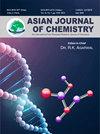有效还原对硝基苯酚的金属有机框架衍生铜碳复合材料
Q4 Chemistry
引用次数: 0
摘要
通过对由 Cu2+ 和 1,4-苯二甲酸盐 (BDC) 组成的金属有机框架 (MOF) 进行单步碳化,制备了铜碳复合材料 (Cu-C),并将其用作降解对硝基苯酚的催化剂。该复合材料通过 X 射线粉末衍射 (XRD)、扫描电子显微镜 (SEM)/能量色散 X 射线 (EDS)、傅立叶变换红外 (FTIR) 和 X 射线光电子 (XPS) 光谱进行了表征。表征结果表明,碳网络中保留了源自 MOF 的氧化铜和金属铜。在 NaBH4 的存在下,Cu-C 复合材料能在几分钟内完全还原对硝基苯酚,其去除率远远高于商用 CuO。在相关催化机理的背景下,NaBH4 浓度在对硝基苯酚还原中的作用得到了强调。在对硝基苯酚还原的连续四个循环中,该复合材料显示出良好的重复使用性,其反应活性仅有少量损失,这表明它具有替代惰性金属催化剂的潜力。本文章由计算机程序翻译,如有差异,请以英文原文为准。
Metal Organic Framework Derived Cu-Carbon Composite for the Effective Reduction of p-Nitrophenol
A Cu-carbon composite (Cu-C) was prepared via single-step carbonization of a metal-organic framework (MOF) composed of Cu2+ and 1,4-benzene dicarboxylate (BDC) and applied as a catalyst to degrade p-nitrophenol. The composite was characterized by X-ray powder diffraction (XRD), scanning electron microscope (SEM)/energy-dispersive X-ray (EDS), Fourier-transform infrared (FTIR) and X-ray photoelectron (XPS) spectroscopies. The characterization affirmed the preservation of MOF-originated CuO and metallic Cu in the carbon network. In presence of NaBH4, the Cu-C composite resulted in a complete reduction of p-nitrophenol within a few min and exhibited much higher removal rate than commercial CuO. The role of NaBH4 concentration in p-nitrophenol reduction was highlighted in the context of relevant catalytic mechanisms. The composite displayed good reusability during four consecutive cycles of p-nitrophenol reduction with only a small loss of its reactivity, signifying its potential as an alternative to noble-metal catalysts.
求助全文
通过发布文献求助,成功后即可免费获取论文全文。
去求助
来源期刊

Asian Journal of Chemistry
化学-化学综合
CiteScore
0.80
自引率
0.00%
发文量
229
审稿时长
4 months
期刊介绍:
Information not localized
 求助内容:
求助内容: 应助结果提醒方式:
应助结果提醒方式:


